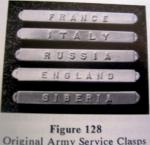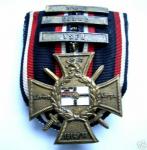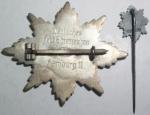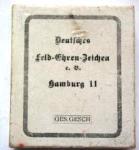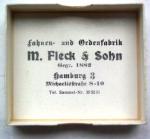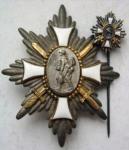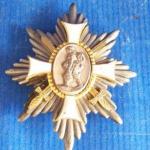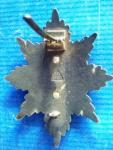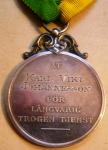-
Posts
9,099 -
Joined
-
Last visited
-
Days Won
4
Content Type
Profiles
Forums
Blogs
Gallery
Events
Store
Everything posted by Kev in Deva
-

Bundesrepublik Fire brigade medals?
Kev in Deva replied to Troy Tempest's topic in Germany: Post 1945: Bundesrepublik & DDR
Hallo Troy, a close up of the center motif on the cross would help, but I am confident they are standard modern Fire-brigade items. Kevin in Deva. -
Hallo Gents, with regards Patramonia it seems Romania is now acting sillybuggers, recently I went to send a couple of inconsequental pre communist era medals to the USA, only to have the Romanian Customs agent inform me of the following: 1. Anything over 50 years old is now regarded as Patramonia!! 2.I must go to the local Museum of Antiquities Burea and get a certificate stating its not Patromonia. 3. No, he cant show me the relavent regulations as the new rules have not been printed yet. 4. To show he was wise to my game of trying to sell the "Riches of Romania" to outsiders he informed me that the only military medals worth anything were the ones that took a bullet and saved the wearers life!! 5. And he also stated he did not believe my story that in the E.U. you could post an object anywhere without it being inspected by the Customs Agents of the country first!! Good God man do you expect me to believe people can post anything they want without CONTROL 6. As a personal favour he allowed me to send the items but that in Future, all items would have to have the relavent Certificates. 7. By the way the local Museum of Antiquities dont know of any such new regulations!!! 8. Local U.P.S., T.N.T. and D.H.L. refuse to accept packets with objects inside from Private citizens, only Registered Businesses can post packets, we the common unwashed, may send a letter with paper only!!! Kevin in Deva.
-

VC Help!
Kev in Deva replied to Peter_Suciu's topic in Great Britain: Militaria: Badges, Uniforms & Equipment
Hallo Peter, A Google Photo Search might be the quickest way of locating a good picture which could be credited. Kevin in Deva. -
Hallo Rick, I agree entirely with your comments, the following is stated in the book: The Inter-Allied Victory Medal of WW1. 2nd Revised Edition by Alexander J. Laslo. Army Service (Country) Clasps. The following service (Country) clasps were awarded to Army personnel who served overseas but, were not eligible for a battle clasp. Officer and enlisted crew memners of Army and commercial transports operating from the uS also qualified for those service clasps which encompased the destination of the transport; however, only one service clasp could be awarded to a crew member. About 1,000 men of the Army performed transport service to France and England. It is implied in W.D. G.O. No. 48 and W.D. Circulars No. 188 and No. 46 that more than ones service clasp could be awarded. The possibility is confirmed by W.D. Circular No. 261 of 10 July 1920 which states that "More than one of the country clasps can be awarded. . . . .", but there are two exceptions. The two exceptions are the officer and enlisted crew members of the Army and commercial transports discussed above and the ENGLAND Clasp. The England clasp was awarded to personel who served over seas exclusively in England and no other service clasp country. Victory medals issued with multiple service clasps are extremely rare. The only documented example known to the author has both the FRANCE and ITALY service clasps and was forwarded to a retired Army Major General. FRANCE: For service in France between 6th April 1917 and 11 November 1918. (Approximate number entitled - 621,600) Eligibility for the Victory Medal with France service clasp presumedly extended to the survivors of a group of 223 French-speaking American women who volunteered to serve as uniformed telephone operators for the Army Signal Corps in France and who were granted veterans status during May 1979. At least 25 of these women served in the combat zone at the 1st and 2nd Army Headquarters between 1 September and 11 November 1918; and one of the operators Miss Grace D. Barker, was awarded the Distinguished Service Medal. In all, the Army issued Honorable Discharge Certificates to 18 former members of this group of women. ITALY: For service in Italy betwen 6th April 1917 and 11 November 1918. (Approximate number entiltled - 4,800). SIBERIA For any service in Siberia. (Approximate number entitled - 9,000). RUSSIA. For any service in Russia. (Approximate number entitled - 9,000). ENGLAND For Service in England between the 6th April 1917 and 11th November 1918. (Approximate number entitled - 30,000). Kevin in Deva.
-

Third Reich Awards to Women
Kev in Deva replied to James Clark's topic in State, Civil Awards & Decorations
Hallo James with regard your question about Spanish Nurses, in the Osprey Men-At-Arms book: "GERMANY'S SPANISH VOLUNTEERS 1941-45, The Blue Division in Russia. Text by John Scurr, Colour Plates by Richard Hook there is a picture on page 38, of: Mercedes Mila'a Nolla, appointed by Franco in 1937 as Inspector General of Women Auxiliaries of the "Sanidad Militar", in conference with Lt.-Col Pellicer, Inspector of Hospitals, during a visit to the front in the summer of 1943. In the caption it states ". . . .The caduceus symbol can just be seen on his shoulder-strap. She wears a Spanish Red Cross badge on the left breast, above the Red Military Merit Cross and the 1936-39 Campaign Medals. Page 39, states three Medals to which men of the Blue Division were entitled. 1. German commemorative medal for the Blue Division not issued until 1944. 2.The Spanish Volunteers in Russia Medal, issued by the Spanish Government in 1942. 3. The German "Winterschlact in Osten 1941/42. In the colour plate E 3. Nurse, Sanidad Militar, 1942: caption on page 36 states: The Divisions seriously sick and wounded were treated at hospitals in Mestelevo, Riga, Vilna, K?nigsberg, Berlin and Hof, operated principally by Spanish Medical staff, who included many volunteer Nurses from the Spanish Army and the Falange's Feminine Section. The Army Nurse depicted here is wearing a headdress of khaki wimple and white coif, upon which is pinned a somple grey metal badge of the Spanish Armys medical branch - "Sanidad Militar". Her Khaki blouse has a white collar and cuffs and dark brown leather buttons. Displayed at the throat is the emblem of the Spanish Red Cross and on the left breast Franco's Civil War award to Women Auxiliaries of "Sanidad Militar", the Campaign Medal (1936-39) and a Red Military Merit Cross . . . . . . " I hope its some help, Kevin in Deva. -

Some of the Maltese Patrolcraft
Kev in Deva replied to JimZ's topic in Armour, Vehicles, Ships & Aircraft
So it is disruptive camo to hide the carbon footprint Kevin in Deva -

Some of the Maltese Patrolcraft
Kev in Deva replied to JimZ's topic in Armour, Vehicles, Ships & Aircraft
At a guess a disruptive patern, it makes the boat look smaller than it is Great pictures anyway, thanks for shareing. I believe an Irish Military ship was due to dock in some time during August, they had planned on attending the Romanian Naval Day ceremonies, but some paper shuffler forgot to apply to the Turkish authorties for permission for the ship to transit Turkish waters, so they were refused access to the Bosperous and Black Sea Kevin in Deva. -
Hallo Gordon, a real beauty let me know if you see another Kevin in Deva.
-
Hallo dond, its a general rule of thumb I use, most armies continental as well as in the UK, would have taken recruits at 17 years old,. . . . add approxamatly one year for training etc..etc.. and then he would probably be ready for combat, as I stated its just a rule of thumb and not 100% precise. I use it as a gauge whenever I see bars with a fantastic array of medals from 2-3 + wars to see if it would have been possible. Kevin in Deva.
-
Hallo KIM great detective work , many thanks for your help always nice to add information to a medal even civil ones Kevin in Deva
-
Hallo Tony again off the head I would say circa early 1919 to late 1920, will have to have a look through some of my reference files (written only) that I compiled with regards the book I am working on. As I said in my previous post its just speculation but the image looks like some old pictures I saw a few years ago doing research. It might just as easily be a mixed patrol of British Army units, which happened as well. Kevin in Deva.
-
Hallo Tony, funny, but for some reason post 11 puts me in mind of the "Black and Tan" - "Irregulars" in Ireland circa 1918 - 1920 period, now I can't say for sure, buts its just the look of the uniforms and leather ammo pouches. A lot of patroling was done using lorries (Crossley Tenders?) between towns and villages in that eriod. Kevin in Deva.
-
Hallo Henke Have you any better pictures?? Its got medals for: 1. The Prussian - Franco War of 1870-71 Non-Combatant Steel award (but) on Combatant ribbon!! 2. Prussian - Austrian War of 1866, 3. Unknown to me (picture to small). 4. 100 Centenery Medal for Kaiser 1. (1897) awarded to the military and Civil service. and a Swedish medal (?). The 3 medals: 1 2 & 4; are fairly common to find, the value of these together about 70 - 90 Euros Add another 30 - 40 for the bar and ribbons. It would also be nice to see a picture of the rear as well. Kevin in Deva. PS Dave thanks for pointing out my error
-
Hallo Alex, just off the head, and I stand open to correction, but I think this got issued as a commemorative medal, to old survivors from his French Regiments from the "Old Days" of pre Waterloo vintage, as a reward for the faithful service. Must dig deeper and see what I can find. Kevin in Deva
-
Hallo Tony, some very nice pictures, with regards the young lad under 18s were forbiden to be in combat areas, not to say some did not falisfy their age but if, and when discovered, or after their Mothers reported they had enlisted under age they were usually returned to the Depot Battalion until they reached 18, then they would be sent to the front. Kevin in Deva.
-
Kids Kevin in Deva
-
Kim many thanks for your interest and help!! Kevin in Deva
-
-


